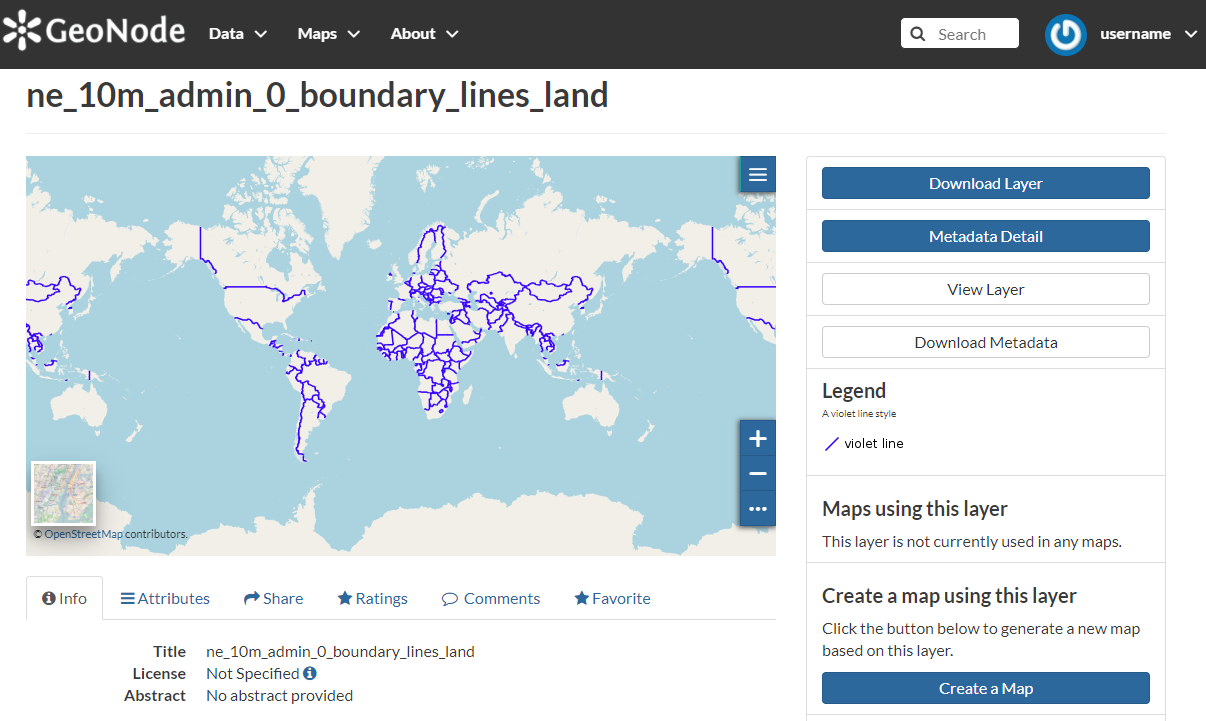
Resource management in GeoNode
“As a content management platform, GeoNode provides various resource management features for different content types.”
The GeoNode platform supports resources of various content types. The three main resource types available in GeoNode are:
- Layers - spatial data in raster or vector format
- Documents - additional files and auxiliary data
- Maps - interactive composition applications
The primary content intended to be managed within GeoNode is spatial data, stored on the platform as Map Layers, which will be the focus of this section. GeoNode provides various features for the resource management of map layers, including the customisation of predefined layer styles and symbology, metadata management, and options for governing the rules for data publication, sharing and downloads.
Maps can be created which contain multiple layers, and documents can be linked to various layers within a map.
The core features used for the resource management of layers include:
- Data downloads - map layers can be downloaded in multiple formats as raw data (e.g. in shapefile format), or as rendered media (e.g. jpeg image or pdf)
- Metadata details - the metadata form visualizes the captured metadata for the layer.
- Editing tools - provide edit capabilities to manage and update layer metadata, styles, thumbnails, and input data
- View layer - preview the layer within an interactive map
- Download metadata
- Create a new map - create a new map with the current layer as the only object within the map
- Styles - review and visualize the available layer styles and symbologies
- Refresh attributes and statistics - update the current layer with any changes to attributes and statistics
- Empty tiled layer cache - remove any cached data for the layer to ensure that all content served by the map services contains the latest updates
- Change layer permissions - edit the access control settings for the layer
Note that the available features may change depending on the type of resource being viewed. For example, a map may include a specific layer but will not display any options for editing the layer data or metadata.

You try:
Goal: To explore the GeoNode resource management features
Generate a customised layer thumbnail
- Navigate to the Layers menu.
- Zoom in to a smaller area on the map.
- Click on the editing tools and select set thumbnail.
- Navigate back to the layers page and inspect the changes.
Download layer data and and perform basic permission management
- Select the layer to visualize its properties.
- Click Download Layer
- Inspect the available options specified. Proceed to download them and inspect the result.
- Click on Change Layer Permissions towards the bottom of the page
- Change the option Who can download it Untick Anyone and save your changes.
- Ask a colleague to refresh their GeoNode and let them look at the download option for the layer you have changed.

More about managing GeoNode resources
GeoNode supports multiple resource content types, primarily layers, documents, and maps. These resources share many common management options, however, there are some features which are specific to a particular resource type.
One of the most powerful features of GeoNode is its content discovery tools, particularly the search functions. Most objects on GeoNode are able to be tagged with a series of keywords which make searching and filtering items simple and powerful. These keywords extend not only to content types and their associated metadata, but to other GeoNode items such as user profiles and groups, so always be sure to inspect the object properties carefully and include keywords wherever possible. The keyword capture is typically a single field which allows for a comma-separated or space-separated list of keywords, so you can assign multiple search terms to a single item.
Be sure to communicate with your team to outline some common conventions for your keywords, as the more consistent users are with tags, the better the platform content discovery functionality will work.

Further reading:
-
Managing Layers https://docs.geonode.org/en/master/usage/managing_layers/index.html ❗
